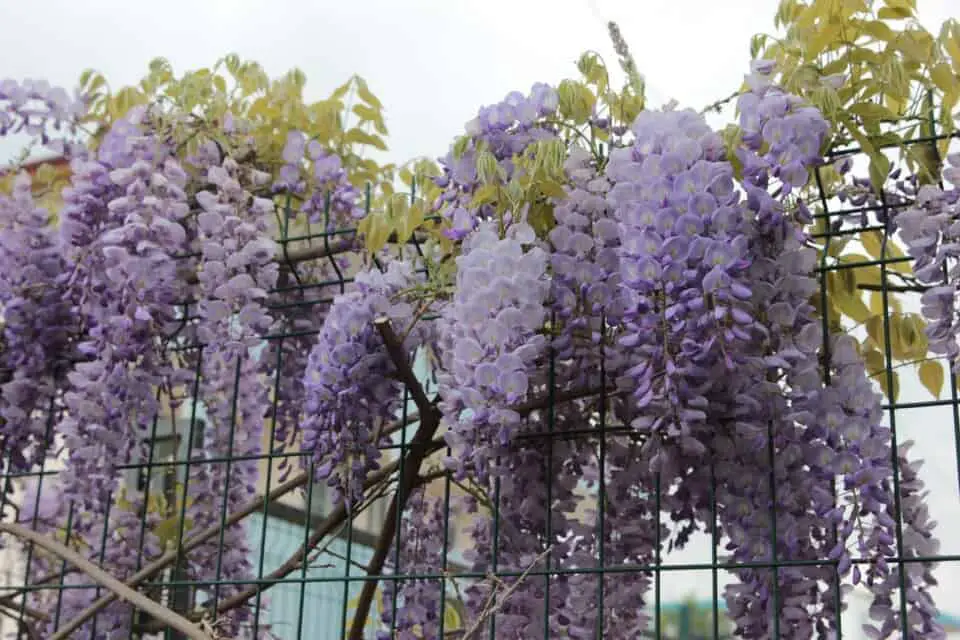Some links in the post are affiliate links and I get a commission from purchases made through some links found in the post.
What was your reaction when you saw the wisteria for the first time? I remember mine. And the most fitting word was awe.
I was so eager to plant the climbing vine that I was already thinking of which part of my garden would be the best to support its growth.
In a matter of weeks, I was heading home with my wisteria. And because I wanted the cascading effect, I started preparing a spot by the house, only for my cousin to ask me what I thought I was doing.
“You will damage the wall of the house!” she said, beckoning me to move further from the wall and more towards the garden.
I was unsure that the wisteria could have such an effect. But after reading about it, I learned that there was a lot of truth to her fears.
Before I get into some of the most common problems you will face with your wisteria, I want to get into something I feel that other gardeners may not know – it could save you a lot of structural work in the future!
Do Wisterias Damage Walls?
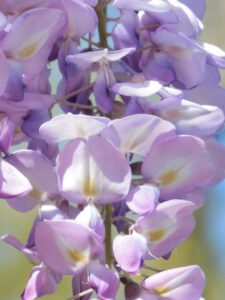 The answer is yes and no. It isn’t very clear – I know. It took me a while to understand how both could suffice as answers. But this is the case.
The answer is yes and no. It isn’t very clear – I know. It took me a while to understand how both could suffice as answers. But this is the case.
The vines on wisterias do not adhere to walls or such surfaces. Instead, they rely on support to make their way around a wall.
That means that they cannot damage walls. So, training a wisteria on your wall should not be an issue. What you need to consider are the roots.
You may already have heard that wisterias are very aggressive. And this aggressiveness does not point to the twining of their vines. Instead, it refers to how fast and widespread their roots grow.
Whether you grow the Chinese or Japanese varieties, you must always consider that the roots can spread so much that they could weaken surrounding structures. That includes your home’s foundation, sewer systems, walls, pathways, etc.
Remember that this is a woody plant, and its roots are thus sturdy enough to dig deeper.
And when they come across a barrier that keeps them from spreading, they will start pushing it. So, yes, your wisteria can pose a threat to the structures in its path.
So, what happens if you want to train your wisteria along your wall without risking damage to your house? The good news is that you do not need to forgo aesthetics for fear of damaging your walls.
The alternative is installing corrugating panels at least six feet long and wide to ensure the plant’s roots do not near the wall. If you can install such (or any other strong) barrier, you can have your cake and eat it.
Can’t you just let the wisteria root grow and control it over time? Wisterias are invasive species. Once they establish, it isn’t easy to get rid of them.
You would need to combine chemical and manual means to get rid of the roots, which would be very costly and time-consuming.
It’s best to avoid this headache altogether by installing a barrier before the problem gets out of hand.
What Are the Common Problems with A Wisteria?
Now that we have structural damage out of the way, let’s consider some of the issues you may encounter when caring for your wisteria.
I will also cover how you can deal with each of them. You will realize that some of these problems relate to the same causes.
Most importantly, you will see just how important basic care routines are and how they impact your wisteria’s well-being.
The common problems of a wisteria are; you’re wisteria not blooming or flowering due to it not being mature enough, not enough light, too much fertilizer, pruning incorrectly, water issues and frost damage.
Other common problems for your wisteria is losing leaves, wilting, not growing, turning yellow and turning brown.
Why Is My Wisteria Not Blooming/ Flowering?
The blooms on wisterias are so beautiful that they are why most gardeners have these plants in their homes.
I’ll be the first to admit that were it not for the cascading blooms, wisterias would not have found their way into my space.
So, I can imagine just how disappointing it would be to spend years caring for your wisteria only for it not to bloom. What could be the cause?
1) Your Plant is Not Mature Enough
Did you know that some people wait up to 20 years before their wisterias start blooming? Yes, that’s always a possibility.
But in most cases, wisterias often take about 3 to 5 years before they can establish themselves enough to start flowering. Of course, this comes down to factors such as:
- The species you choose: Some species take much longer to mature than others, with some taking as many as 25 years while others take as few as 3 years.
- How friendly the climatic conditions are: Wisterias will do much better in favorable growing conditions. Ideally, the following are the best climates for wisterias:
- American Wisterias do best in USDA hardiness zones 5 to 9. Under these conditions, they grow to lengths of about 20 to 30 feet at maturity and bloom in the spring and summer.
- Chinese Wisterias: These plants, native to Asia, are quite aggressive and grow to lengths of 10 to 25 feet at maturity. They prefer USDA hardiness zones 5 to 8 and bloom between May and June.
Thus, if you were to grow the wisterias outside these conditions, it would be a while before they bloomed.
- Whether the wisteria was grafted: If you get the usual wisterias, you will wait a long while before the plant is mature enough to bloom. The alternative would be to get a grafted wisteria, allowing you to wait about 3 years before your efforts bear fruit.
- Whether you grew the wisteria from seed: Wisterias grown from seed take a long time to mature. It comes down to their juvenile stage, where they focus on developing leaves rather than flowers. Interestingly, this stage can last as many as 5 to 10 years. So, if you want to skip this stage and move to blooming, the best option is to grow your wisteria from grafted wisterias or choose cuttings.
- The care given to the plant: Your wisteria requires you to put in some work to promote blooming. And this includes ensuring it gets its basic needs (water, light, and nutrients) and pruning it annually to promote healthy growth.
These all contribute to how fast or how slowly the plant blooms.
What Can You Do About It?
Some wisterias never bloom, no matter how much time and care you put into them. Thus, the best approach to maturity-related blooming is:
- Ensure you get a wisteria with a high chance of blooming: It’s always good to be picky when getting your plant. Please get to know how it was grown (from seed or cuttings) and whether any grafting took place. Getting a grafted wisteria that was grown from a cutting will give you the best chance of your plant blooming in a few years.
- Patience: No matter the kind of wisteria you take home, you must give the plant time to establish and push past the juvenile stage. At this time, all you can do is wait and care for the plant.
If maturity is not the issue, let’s uncover other possible causes:
2) Your Plant Needs More Light
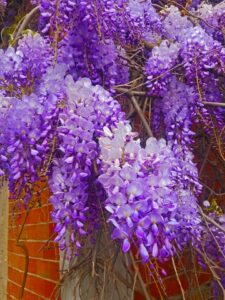 Most flowering plants enjoy being in the full sun for at least 6 hours. And the wisteria is not different. When the wisteria is in full sun, it can produce enough food to support its growth.
Most flowering plants enjoy being in the full sun for at least 6 hours. And the wisteria is not different. When the wisteria is in full sun, it can produce enough food to support its growth.
And this energy eventually plays a vital role in the development of blooms.
When the wisteria is not in full sun, it cannot produce such energy, and its blooming suffers. Let me paint a picture of how different kinds of lighting affect your plant:
1) Bright and Direct Light
This light exposure, also known as full sun, does not feature any obstructions. The sun’s rays thus hit the plant directly almost or all day. Under such light, the plant makes enough food to sustain the development of healthy blooms.
2) Bright and Indirect Light/ Partial Sun/ Partial Shade/ Filtered Light/ Dappled Light
This exposure features some obstruction/ shade that deprives the plant of direct access to the sun.
For example, the plant may receive morning sun, but it may not receive afternoon sun because of its position. Such a plant can still make enough food to sustain blooming. However, the blooms would be few.
3) Medium and Indirect Light
This light and low and indirect light are not enough to give the plant energy to bloom. As such, the plant would focus more on producing healthy foliage. If your plant seems healthy but won’t bloom, it likely needs more light.
Is your plant getting enough light?
How to Give Your Plant Adequate Light
Your wisteria should be in full sun for at least 6 hours a day. The best way to achieve this is by:
- Planting the wisteria towards the south of the garden where it can receive at least 6 hours of bright and direct light,
- Planting the wisteria to the west of the garden where it can receive afternoon sun, which tends to be much hotter than the morning sun, or
- Relying on artificial light to supplement the natural light your plant receives. LED lights are good choices as they are highly energy efficient.
When positioning your plant, consider its growth patterns and whether this position will suffice when the plant is 20 feet long.
3) Your Plant Needs Less Fertilizer
The common reaction to caring for a non-blooming plant is to fertilize it even more. Are you guilty of this? The thing is that the wisteria does not need that much fertilizer.
In fact, it can do with very little feeding and still produce healthy blooms. When you feed the plant with more fertilizer than it needs, you create a problem where it has access to too much nitrogen.
Nitrogen encourages the plant to produce more foliage. So, you end up with a wisteria with many leaves but no blooms to show for it. Does this sound like your wisteria?
Dealing With Overfeeding
All wisteria species prefer having little to no fertilizer over being overfertilized. Don’t get me wrong – fertilizing your wisteria will encourage blooming, but there’s a limit to this perk. So, here’s how you should go about it:
- Unless your plant shows signs of underfeeding, you should not feed it more than once annually. Usually, this should be before it starts developing buds.
- You should use a fertilizer high in phosphorus as this is the nutrient that encourages blooming. Avoid fertilizers that rely on nitrogen as nitrogen will only encourage foliage production, which will hamper successful blooming.
- If you would rather take on an organic approach, you can add a layer of compost around the wisteria. Please note that compost has a high water retention rate, and you should thus add a little at a time.
If you’ve been feeding your plant with a nitrogen-rich feed, you’ll need to take a step back and give the plant time to acclimate to the new feeding schedule.
You may also like: Wisteria vs lilac
4) You’re Pruning the Wisteria Incorrectly
To prune or not to prune is a dilemma that plagues many gardeners as they gear up for the flowering season.
If you do not prune your wisteria, it focuses its energy on new foliage rather than new flowers. And that can set it back regarding pruning.
Moreover, lack of pruning results in an awkward shape for your plant and can encourage it to grow beyond its bounds. It also allows diseased plant parts to remain on the plant, posing a risk to the healthy parts.
However, pruning the wisteria incorrectly is just as bad. When pruning the wisteria, you must understand:
- Whether it blooms on new wood or old wood, and
- The best time to prune the plant.
Interestingly, the pruning times for the wisteria species differ quite a bit.
Pruning the Wisteria
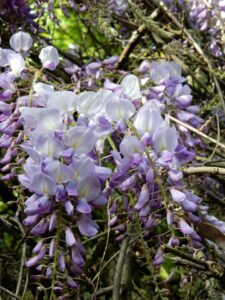 Let’s start with the American wisteria. This plant only blooms on wood produced the previous year.
Let’s start with the American wisteria. This plant only blooms on wood produced the previous year.
Such branches are highly flexible and much thinner than the others on the plant, so it’s easy to seek them out. When pruning, you should focus on getting rid of the old wood. Additionally, you should prune this plant twice each year.
The first time should be before the plant develops leaves in the spring. And the subsequent pruning should take place once the flowers fall off.
During this phase, you should cut back the plant by about 5 inches to control its growth and encourage healthy blooms the next season.
As for the Chinese wisteria, pruning is essential in controlling the plant’s growth as it tends to send out runners. You should cut the plant back in late winter by removing half of last year’s growth.
When doing so, ensure you leave some buds on each stem. Once the plant flowers, you should prune it again to maintain its shape and control its growth.
You may also like: Wisteria tree vs vine
5) Your Wisteria Needs More Water
Wisterias generally grow in moist soil in their native habitats. You find them by rivers, swamps, lakes, etc. As such, water is essential in replicating their natural habitats and promoting their growth.
Without it, the plants cannot photosynthesize enough to make enough food for vertical growth and blooming. Moreover, lack of water dehydrates the plant, forcing it to redirect its resources to healing.
Dealing With Underwatering
The wisteria can withstand a bit of drought. However, if this dehydration comes about when the plant has started flowering, this can halt the blooming processes. To avoid this, you should:
Ensure the plant gets at least one inch of rain a week
This should not be an issue in wet regions. But in warmer regions, you may need to supplement the rain with more watering.
Ideally, you should water the plant when the top two inches of the soil feel dry to the touch. Or you can use a moisture gauge to check if the plant needs water.
Anytime the soil feels dry, follow through with soaking the soil, more so in the hotter months when the soil dries out faster.
Amend the soil with compost to increase its water retention rate
If you think that the soil loses water owing to a high drainage rate, you can always add some compost to the mix. Wisterias do not like being transplanted, and it’s always best to make the changes without moving the plant.
Mulch the soil around the wisteria
Mulching reduces the water loss rates and makes it easier for the plant to withstand hotter temperatures. And as it breaks down, it feeds the plant.
It would help if you left an inch between the mulch and the plant to avoid creating a home for pests. Also, do not use mulch thicker than 1.5 inches.
Please note that your plant is likely to suffer from underwatering if you plant it in USDA zones 10 and higher.
6) Your Plant Needs Less Water
Knowing that the wisteria grows in moist soils might prompt you to grow it in wet soils. But that would not be ideal.
When you leave the wisteria in wet soil for too long, its roots start drowning and cannot take in moisture and vital nutrients.
As a result, the plant starts exhibiting signs of distress like yellowing and wilting. And if you do not act fast, this waterlogging creates the ideal environment for fungal growth.
Root rot follows, damaging the plant’s roots and killing it from within, encouraging diseases to attack the wisteria. And once root damage has exceeded a certain extent, the plant dies.
How to Avoid Overwatering
You can keep your plant safe by:
- Only watering it as needed as outlined under underwatering the wisteria, and
- Amending the soil with sand and other coarse-textured materials that can encourage more water drainage.
If your wisteria has suffered root rot, you have no option but to move it to another location. Please note that this should be the last resort as it will put a lot of strain on your plant.
7) Your Wisteria Has Suffered Frost Damage
Buds show up on the wisteria towards the end of summer. Following their formation, the plant goes into dormancy and waits for spring before its buds can start blooming.
Once they start opening up, it is important that the temperatures remain optimal. But sometimes, that is not the case, and a late frost gets in the way.
If this happens, the buds get damaged, and the wisteria does not bloom as well as you expected.
What Can You Do About It?
Frost damage can eliminate the healthy blooms. Here is how you can deal with it:
- Prevention: The best approach is to protect your wisteria from frost damage by covering it with a cloth until you are sure the last frost has passed.
- Remedy: If frost damage occurs, you should wait to see if the plant will recover. In many cases, the plant recovers and still develops some blooms.
If no blooms show up, the best you can do is prune the plant and wait for the next year, where the results will hopefully be better.
You may also like: 6 great benefits of owning a wisteria
Other Issues with the Wisteria
I mentioned that most problems are quite related. Please browse through the options below and find their solutions in the abovementioned remedies.
1) Why Is My Wisteria Losing Its Leaves?
- The natural process in readiness for dormancy
- Exposure to too much heat
- Underwatering
2) Why Is My Wisteria Wilting?
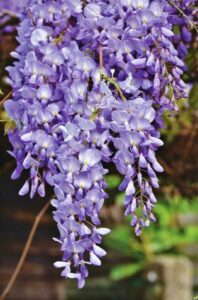 Overwatering
Overwatering- Root rot
- Underwatering
- Pest infestation: Did you know that wisterias are also susceptible to pest infestations? Examples include aphids and scales, which can multiply fast if not dealt with timely. When such pests invade your plant, they feed on its juices and tissues, robbing it of its ability to make food. The plant spends more energy on healing rather than growing and blooming. The best way to deal with pests is to wipe the plant with insecticidal soap and start using neem oil on the plant parts.
3) Why Is My Wisteria Not Growing?
- Lack of pruning
- Low access to full sun
- Underfeeding
- Underwatering
4) Why Is My Wisteria Turning Yellow?
- Overwatering
- Too much exposure to the sun
5) Why Is My Wisteria Turning Brown?
- Overwatering
- Too much exposure to full sun
- Pest infestation
In the above cases, the reasons behind negative changes in your wisteria are largely similar. The best way to avoid these issues is to understand what your wisteria needs and provide it with the same all year-round. Happy Gardening!

